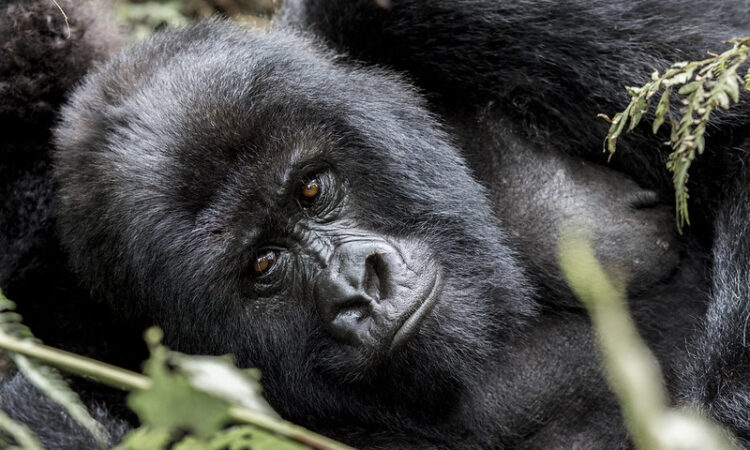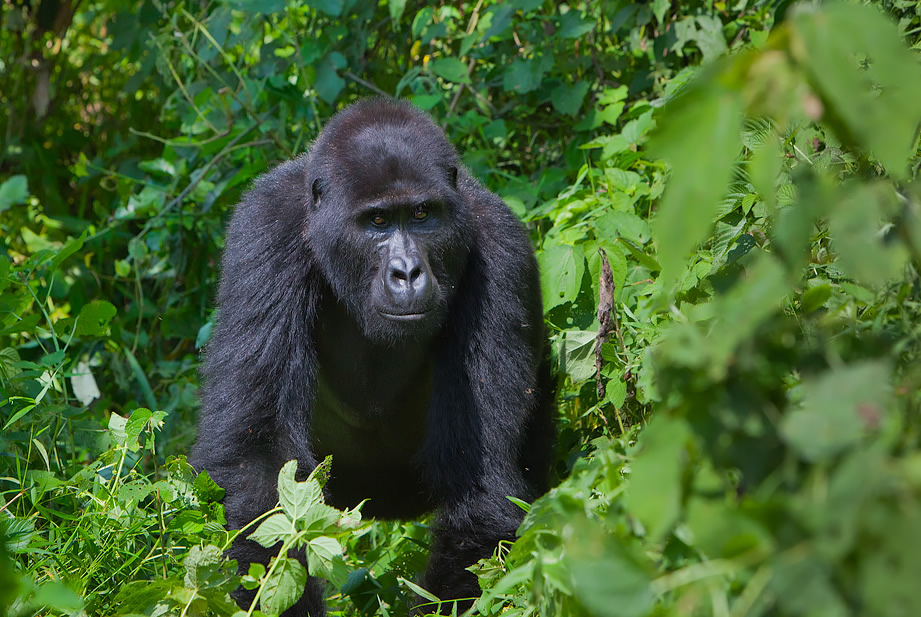Gorilla Safaris/Tourism in Rwanda and Uganda: Gorilla safaris and tourism in Rwanda and Uganda involve viewing gorillas in their natural environment or in the wild. Tourism of this kind is highly popular in East, Central, and West Africa. The top gorilla tourism locations are Uganda, Rwanda, and the Democratic Republic of the Congo. How did it all start?

Gorilla tourism and conservation began in 1902, when a German captain named Robert von Beringei found mountain gorillas in what is now Rwanda. Later, in 1925, Carl Akeley, an American naturalist, persuaded King Albert of Belgium to establish the Albert National Park (now known as Virunga National Park). Albert National Park became Africa’s first.
In 1959, an American naturalist named George Schaller conducted the first comprehensive study of mountain gorillas in Albert National Park. When the Belgian Congo gained independence in 1960, the Albert National Park was separated into two parts; the Congo’s Virunga National Park and Rwanda’s Volcanoes National Park.
In 1967, a watershed moment in gorilla tourism, study, and conservation happened. Dian Fossey, an American naturalist, began a systematic study of mountain gorillas in Volcanoes National Park after being invited by Dr. Leakey. Her research was a huge success, with substantial discoveries in gorilla habituation. Gorilla habituation is the process by which wild gorillas are taught to feel comfortable in the company of people.
The Rwanda office of tourism and national parks was established in 1973 to draft new legislation controlling operations in national parks. Poaching and the pet trade in young gorillas persisted from 1970 to 1980, despite efforts to safeguard animals. Dian Fossey battled tirelessly to conserve gorillas and to discourage gorilla tourism. Fossey believed that gorillas ought to be kept alone and undisturbed by people. The pet trade and the slaughter of whole gorilla families in order to catch their young generated international outrage and urgency to protect and save wild gorillas. Dian Fossey’s favorite gorilla, Digit, was also slain.
The slaughter of gorilla groups left in the wild led the Rwandan government and other environmentalists recognize that gorilla tourism may save them. The advantages of gorilla trekking would compel locals around parks to safeguard the creatures and even report poachers.
Gorilla trekking in Rwanda’s Volcanoes National Park was originally introduced in 1973, but only for a brief time before being discontinued due to a lack of experience and research on the effects of human-gorilla contact. There were no clear rules and regulations for gorilla trekking enforced during that time.
In 1979, there was a big mountain gorilla effort that marked a watershed moment in gorilla conservation. The Rwandan government and a group of wildlife support groups met and decided to implement gorilla tourism, community education, and anti-poaching initiatives to enhance gorilla conservation.
These were the African Wildlife Leadership Foundation (A. W. L. F), which has now been renamed the African Wildlife Foundation (A. W. F), and the Flora and Fauna Preservation Society (F. F. P. S). The convention’s ideas eventually helped to establish tourism-related employment and earnings, which encouraged local people and officials to work together to save gorillas.
How Gorilla Safaris/Tourism in Rwanda Begun?
Gorilla Safari Tourism began with the habituation of two gorilla populations. The goal was to get them habituated to human presence before allowing tourists in. Groups 11 and 13 were chosen since they were both close to the Karisoke center. Stilgar, the silverback in Group 11, was a very quiet silverback.
Because they were so far away from the beginning location, other gorilla families were not considered for habituation at the time. Furthermore, several gorilla groups were inaccessible due to hostile silverbacks. Two groups of participants participated in the first experimental hiking. The first group were Rwandan residents in October 1979, while the second were non-resident visitors.
The first hiking trips were confined to only six persons per family, with only one hour with the gorillas. This was done to minimize stressing the gorillas through extended human contact. At the time, the journey cost $20 USD per person. This first walk also paved the groundwork for the development and implementation of gorilla trekking guidelines. Many people have been observed visiting the Volcanoes National Park for gorilla trekking in a short period of time.
This resulted in an increase in the quantity and quality of lodging facilities around the park, as well as many new employment for locals as trekking guides, patrolling guides, and porters, among other things.
Dian Fossey was discovered slain in her hut at Karisoke Research Center on December 27, 1985. She was put to rest next to Digit, her favorite silverback, at the gorilla cemetery she had established at Karisoke. Her death has remained a mystery to this day.
Following her death, a mountain gorilla population census was done in 1989, which indicated the existence of around 324 gorillas in the Virunga conservation area and approximately 320 gorillas in the Bwindi impenetrable national park, for a total of 644 gorilla individuals.

Poachers murdered ‘Mrithi,’ a male silverback gorilla from group 13 (one of the first two habituated gorilla groups), in 1992. As if his loss wasn’t enough, around 18 to 22 other gorillas were slain during Rwanda’s civil conflict in 1994. The overwhelming death of gorillas during the 1994 massacre effectively ended gorilla tourism.
The Rwanda administration of tourism and national parks ultimately reopened the volcanoes national park for gorilla tourism in 1999, with gorilla trekking permits costing $250 US dollars. The gorilla permit charge has risen over time and is now 1500 US dollars per person.
How Gorilla Safaris/Tourism in Uganda Started?
Gorilla tourism in Uganda began in 1991, when the government designated Bwindi Impenetrable National Park as a protection area for mountain gorillas. Tourism in Uganda took a long time to grow since it was prohibited by then-President Idi Amin in the 1970s. Amin, on the other hand, saw national parks as good hunting grounds for wild animals. In the 1980s, the country also experienced civil war, which lasted until 1986, when the National Resistance Army (NRA) triumphed and took control of Kampala.
This regime shift resulted in the restoration of peace and order within the country, as well as the establishment of new governmental institutions and the enactment of new laws. In the 1990s, Uganda was ready to work with the other nations that were conserving gorillas.
In Uganda, the Mubare gorilla family was the first to be habituated. This was simple because the silverback ‘Ruhondeza’ proven to be of good character and open to humans. In 1993, the Mubare family was introduced to the public for gorilla tourism for the first time. The number of habituated gorilla families in Uganda has increased to four by 2004. The Mubare family, the Rushegura family, the Habinanja family, and the Nkuringo family were among them. At the time, gorilla permits were 360 US dollars per person.
By the year 2012, there were already 9 habituated at the Bwindi Impenetrable National Park, with two additional trekking spots created in Ruhija in the park’s central portion and the Rushaga sector in the park’s south-eastern half. Gorilla permits are now priced at $700 USD per person.
Why Gorilla Safaris/ Tourism in Rwanda and Uganda is Important?
Gorilla tourism has been and continues to be extremely important to the nations and local communities where the primates may be found in a variety of ways: The proceeds from gorilla trekking permits have enabled conservation operations like as national park preservation to be funded. Some of the revenue collected by permits is used to fund the wages of park officials, as well as the patrol crew that ensures there are no intruders or poachers within the park.
The continuous presence of people in and around the parks has helped to deter poachers whose goal is to destroy rather than protect animals. Furthermore, the funds produced by gorilla tourism have allowed the park authorities to conduct thorough monitoring in order to discover new births, deaths, and potential health issues.
The proceeds from gorilla tourism have been used to construct and enhance other government sectors such as health and education, among others. Local communities gain when money earned by gorilla tourism is used to build better roads, health facilities, and schools. The money earned by gorilla trekking permits has also allowed governments to hire researchers, veterinary physicians, and other professionals who check on the primates’ overall well-being on a regular basis.
Tourists that come for gorilla trekking help local communities by staying in their lodges, engaging in local events, dining at local restaurants, and purchasing crafts and souvenirs. This has significantly improved people’s livelihoods and quality of life.
To summarize, gorilla tourism in Africa, notably in Rwanda, Uganda, and Congo, has gone a long way since Dian Fossey’s time. It was discovered that allowing this type of tourism was the greatest way to collect funds for gorilla conservation in these poor countries. The proceeds from gorilla tourism have been utilized to support conservation efforts, construct infrastructure, and provide opportunity for populations living near gorillas. Without tourists, gorillas would be left alone in the wild, vulnerable to poachers.


